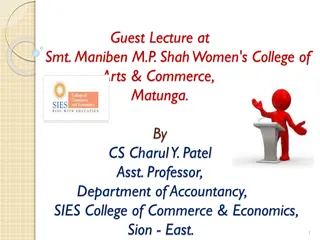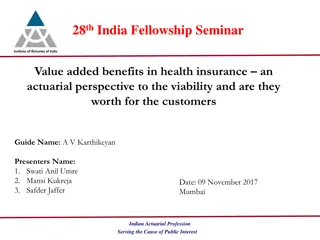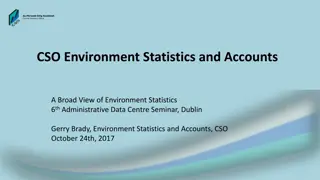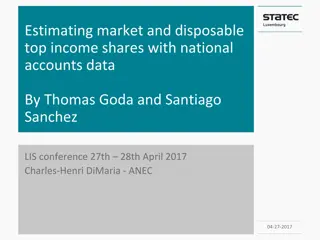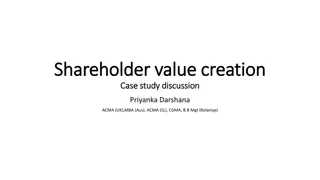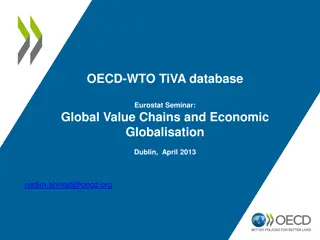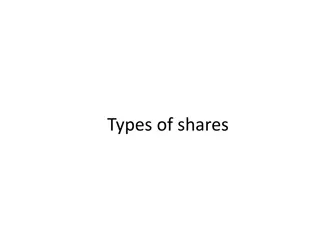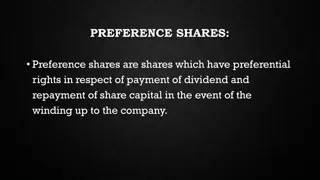Analysis of Measuring Services and Value Added Shares in National Accounts
Measuring services in national accounts involves challenges due to the intangibility and heterogeneity of services. The estimation of output and prices is complex, especially in the fastest-growing sector of services. This analysis includes coverage of various industries and their NIC codes, as well as the value-added shares in total GVA, highlighting the contribution of different sectors.
Download Presentation

Please find below an Image/Link to download the presentation.
The content on the website is provided AS IS for your information and personal use only. It may not be sold, licensed, or shared on other websites without obtaining consent from the author.If you encounter any issues during the download, it is possible that the publisher has removed the file from their server.
You are allowed to download the files provided on this website for personal or commercial use, subject to the condition that they are used lawfully. All files are the property of their respective owners.
The content on the website is provided AS IS for your information and personal use only. It may not be sold, licensed, or shared on other websites without obtaining consent from the author.
E N D
Presentation Transcript
MEASURING SERVICES IN NATIONAL ACCOUNTS NATIONAL ACCOUNTS DIVISION CSO NEW DELHI, INDIA
MEASURING GVA OF SERVICES Services are the fastest growing sector. Estimation of output and prices entails various theoretical and practical difficulties Economic characteristics of services - intangibility and heterogeneity. Challenges in measuring volumes or output and value added at constant prices
COVERAGE INDUSTRY Maintenance and repair of motor vehicles and motor cycles NIC CODE INDUSTRY NIC CODE INDUSTRY NIC CODE Supporting & auxiliary transport activities Public administration and Defence 452+45403 522 84 Coaching centres + Activities of the individuals providing tuition Sale of motor vehicles 45-45403-452+473 Courier activities 532 85491 Whole sale trade except of motor vehicles 46+92001 Cable operator 61103 Education excluding Coaching 85-85491 Retail trade (except motor vehicle) Repair of computers and personal and household goods Other communication (Telecommunication) Recording, publishing & broadcasting services Human health activities & Care services 47-473+92002 61-61103 86.87,88 Recreational, cultural and sporting activities 90,91,92(- 92001,92002),93 95 58,59,60 Activities of membership organisations Hotels & Restaurants 55,56 Financial services 64,65,66 94 Washing and cleaning of textile and fur products Transport Via Railways 491 Real Estate Activities 68 9601 Scheduled passenger land transport Hair dressing and other beauty treatment 4921 Computer and Related activities 62,63 9602 Non-scheduled passenger land transport 4922 Legal activities 691 Custom Tailoring 14105 Freight transport by motor vehicles Funeral and other personal service activities 49231 Accounting, book-keeping 692 9609, 9603 Research and development & Other Professional Services +veterinary activities Administrative and support services excluding Renting of machinery & equipment without operator, personal / household goods Services of owner-occupied Dwellings Activities of households as employers of domestic personnel Freight transport other than by motor vehicles 49232 70,71,72,73,74,75 97 (NIC Code is based on ISIC Rev 4) Water Transport 50 78 to 82 Storage and warehousing 521
VALUE ADDED SHARES GROSS VALUE ADDED SHARE IN TOTAL GVA HOUSEHOLD +QUASI CORPORATONS IN GVA SERVICES * INDUSTRY GROSS VALUE ADDED SHARE OF Trade & repair services 17.0 10.4 1.5 Hotels & restaurants Transport, storage, communication & services related to broadcasting 1.0 5.9 7.0 0.9 Financial services Real estate, ownership of dwelling & professional services Public administration and defence 5.8 16.2 15.3 - 5.9 6.6 Other services 7.5 48.1 TOTAL 53.0 * Quasi corporations are unincorporated enterprises maintaining accounts and source of data is the NSS enterprises survey.
VALUE ADDED SHARES GEN GOVT PUBLIC CORPN PRIVATE CORPN QUASI+ HH INDUSTRY TOTAL Trade & repair services 0 2.3 11.3 86.5 100 Hotels & restaurants Transport, storage, communication & services related to broadcasting 0 0.6 23.0 76.4 100 0 21.5 33.4 45.2 100 Financial services Real estate, ownership of dwelling & professional services 0 49.2 42.3 8.5 100 0 0.2 43.8 55.9 100 Public administration and defence 100 0 0 0 100 Other services 39.7 0 13.8 46.5 100 GVA at basic prices 16.2 9.4 26.3 48.1 100
Sources of data Main Data sources Institutional Sector General Government ( non market producer) and Public corporations Budget documents & Annual Reports Private Corporate sector Annual accounts of companies as filed with the Ministry of Corporate Affairs (MCA) under their e- governance initiative, MCA21 Cooperatives, Quasi corporations & Households NSS Surveys on employment and unemployment and consumer expenditure; Unincorporated Non-agricultural Enterprises; NSS Survey on
ESTIMATING GVA ( Non Financial Services) Market producers : output in nominal terms is measured from the books of accounts broadly as sum of sales and changes in inventories. Non-market producers : output is measured at nominal prices on the basis of input cost approach, as sum of inputs, compensation of employees and consumption of fixed capital(CFC) CFC is compiled following the procedure of Perpetual Inventory method.
Household sector Bench Mark Year estimate : Estimated Labour Input and the value added per worker (VAPW) in the activity. For subsequent years, the GVA is estimated by extrapolation using appropriate indicators relevant to the economic activity Effective LI method used for compiling estimates in some sectors to address the issue of differential labour productivity by assigning weights to different categories of workers engaged in an economic activity based on their productivity. Nested Cobb-Douglas function has been used for computing the weights of different categories of workers.
INDICATORS USED Industry Current prices Constant prices Indicators for constant prices Trade & Repair Services Index of sales Tax turnover, Motor vehicles sales growth superimposed by WPI of traded commodities, Service tax growth Extrapolation/single deflation Sale of motor vehicles, WPI traded commodities Hotels and Restaurents Corporate growth Single deflation WPI traded commodities Road Transport Extrapolation Registered vehicle growth Growth in regd. vehicles, superimposed by CPI( Transport and communication) Water Transport Base year estimates moved using cargo handled index (major & minor ports) and superimposed by CPI( Transport and communication) Extrapolation Cargo Handled index Services Incidental to Transport Combined growth of Road & Water transport. Extrapolation Combined growth of Road & Water transport.
INDICATORS USED Industry Current prices Constant prices Indicators for constant prices CPI (Trpt. & Comm.), Courier Services Service tax growth Single Deflation Cable Services Service tax growth Single Deflation CPI (Trpt. & Comm.), Telecommunication Service tax growth Extrapolation Minutes of Usage Recording & Broadcasting Services Real Estate & Professional Services Corporate growth Single Deflation CPI (Trpt. & Comm.), Corporate Growth Single Deflation Deflation by CPI (Misc.) For Urban Double Deflation Deflation by CPI (Housing) and Index of Urban housing Gross Rental Repair Maintenance where Gross rental prepared as no. of dwellings * Rent per dwellings Ownership of Dwellings For rural User Cost approach In the user cost approach Stock and CFC at constant prices are estimated through PIM using appropriate price deflators.
INDICATORS USED Industry Current prices Constant prices Indicators for constant prices Education Consumer Expenditure(CE) growth in education (64th and 71st Round) Single Deflation Deflation by CPI (Education) Health CE growth in health (61st and 68th Round) Single Deflation Deflation by CPI (Health) Recreational, cultural and sporting activities Growth in non-food expenditure Single Deflation Deflation by CPI (Recreation/Misc.) Activities of membership organisations Single Deflation Deflation by CPI (Misc) Service tax growth Personal Services (washing, hairdressing, custom tailoring) Growth in non-food expenditure ( from Consumer expenditure survey) Single Deflation Deflation by CPI (General) Private households employing staff Labour Input method Single Deflation Deflation by CPI (General)
Classification of financial corporations Financial corporations sector are divided into nine subsectors according to its activity in the market and the liquidity of its liabilities Central Bank Deposit taking corporations except the central bank Money Market Fund Non-Money market investment fund Other financial intermediaries except insurance corporations and pension funds Financial auxiliaries Captive financial institutions and money lenders Insurance corporations Pension Funds
ESTIMATES AT CURRENT PRICES Central Bank (RBI) - Cost method on the entire operations of the RBI. Deposit taking corporations except the central bank- All nationalized banks, regional rural banks, other scheduled commercial banks including private and foreign banks, Cooperative credit societies etc.( financial intermediaries )
Financial intermediaries Reference Rate (RR) approach Output = FISIM (financial intermediation services indirectly measured) + AR (actual receipts) FISIM = (LR-RR)* average stock of loans + (RR- DR) * average stock of deposits. RR = harmonic mean of lending rate(LR) and deposit rate (DR) for the banking sector Intermediate Consumption (IC) = Management expenses + commission to agents + bank charges + repair and maintenance + other misc. expenses
Financial intermediaries FISIM under RR method does not include: Interest receipts on investments and debt securities Interest Paid on borrowing and debt securities Net Profit on Sale of Investments These are considered as property income and are included in savings AR comprise of misc. income, brokerage, commission income, etc.
ESTIMATES AT CURRENT PRICES Money Market Funds Non MMF investment Funds Output redemption fee, exchange fees, account fees, annual fees such as management fees distribution and other fees and performance fees. comprises of purchase and
Other financial intermediaries except insurance corporations and pension funds Central financial Corporations State Financial Corporations Non-government non-banking financial corporations Development Financial Corporations Share Trading and Investment Holding companies Loan Finance and Asset Finance Financial advisory services Fund management services and portfolio management services, etc.,
Other financial intermediaries except insurance corporations and pension funds deposit taking enterprises (output=FISIM+explicit fees) FISIM = FISIM on loans + FISIM on deposits non-deposit taking enterprises (output=FISIM+explicit fees) FISIM = FISIM on loans In the case of others Output is the value of the explicit fees.
Financial auxiliaries Central supervisory authorities of financial intermediaries and financial markets when they are separate institutional unit Corporations providing infrastructure for financial markets Insurance agents Stock exchanges, Stock broking companies Managers of pension funds, mutual funds (e.g., Asset Management Companies managing mutual funds) Usually these units show explicit service charges received from their customers. Their output comprise of these service charges and their IC is similar to remaining financial sector.
Captive financial institutions and money lenders money lenders output is FISIM : (LR- RR)/100*loan Estimate is derived utilising the information on ratio between loans from banks and moneylenders from the All India Debt and Investment Survey and the loan information from the Reserve Bank of India. Difficult to classify holding companies seperately from the MCA21 database .
Insurance corporations Output: + Premium less reinsurance + Premium supplements : interest received + dividend received + net profit on sale of investments Less Adjusted claims : Claims and surrenders, interest paid, net accruing liability (or change in actuarial reserves), bonus to policyholders, change in equalisation provision + Miscellaneous receipts : Business receipts + redemption receipts Intermediate Consumption (IC) : Management expenses, commission to agents, bank charges, repair and maintenance, other misc. expenses GVA = Output - IC Net accruing liability applicable only for life insurance Change in equalisation provision applicable for non-life insurance 21
PENSION FUNDS Output is estimated as the sum of costs (i.e. intermediate consumption, compensation of employees, capital costs and other taxes less subsidies on production)
ESTIMATES AT CONSTANT PRICES Indicators used are Total credits and total deposits of commercial banks Total deposits and number of members cooperative banks Value of life fund and value of sum assured Gross premium less claims Indicators in nominal terms are deflated using GDP deflator of non-financial sector Consumer Price Index Base year estimates is extrapolated using growth in indicators 23
Challenges and Way forward In the case of financial corporations , emerging areas need to be covered Payments bank Credit card operations Peer-to-peer lending etc. Data availability for a few specific types of financial enterprises, like holding corporations, brass plate units, pawnshops engaged mainly in lending, etc.need to be improved Database on outputs and outcomes alongwith quality aspects, of different non market services like health services required for measuring real output
Challenges and Way forward Absence of suitable service price indices Dedicated survey on services sector using a list frame that is based on list of Companies, sixth economic census and Business Registers, has been conducted as a prelude to Annual Survey of Services. This would provide a regular flow of data pertaining to the organised segment of the services sector. Future plans of annual unincorporated surveys, surveys of services sector and Periodic Labour force surveys would provide real time data on services sector and improve the quality of estimates










